If you’re looking for help to identify ducks with long necks, this will be the best article you read today.
In this post, you will find photos, identification info, calls, and all the fun facts you need.
Examples of ducks with long necks include the northern pintail, ruddy shelduck, muscovy duck, fulvous whistling duck, Indian spot-billed duck, and many others.
Here are 13 of the most interesting ones.
Table of Contents
Ducks With Long Necks
White-winged Duck

- Scientific Name: Asarcornis scutulata
- Lifespan: 10-15 years
- Size: 26-32 in
With a length of 26-32 inches, a wingspan of up to 5 feet, and a weight of 6.5-8.6 pounds, white-winged ducks are one of the largest duck species in the world.
They are also known as white-winged wood ducks and their most recognizable feature is the black and white plumage contrast.
Males have blackish plumage and white heads with black speckles; females are smaller and have mottled heads and upper necks.
White-winged ducks also have thick and long necks; the subspecies living in Sumatra have longer necks and more rounded heads, compared to others.
These ducks can have bright red or orange color of their eyes.
White-winged ducks are rather shy species that feed at night. They consume seeds, grain, rice, aquatic plants, insects, snails, and small fish.
White-winged ducks are found in Asia, around dense tropical evergreen forests, rivers, and swamps.
They inhabit countries like Laos, Thailand, Vietnam, Cambodia, Indonesia, India, Bangladesh, and Burma.
They are cavity nesters that use tree holes high from the ground to build their nests and lay up to 16 eggs. White-winged ducks are monogamous and mate for life.
Due to hunting, habitat loss, and small population, the International Union for Conservation of Nature (IUCN) has listed them as Endangered with an estimated 1,000 individuals in existence today.
Read More: More examples of duck species with black and white plumage
Wandering Whistling Duck
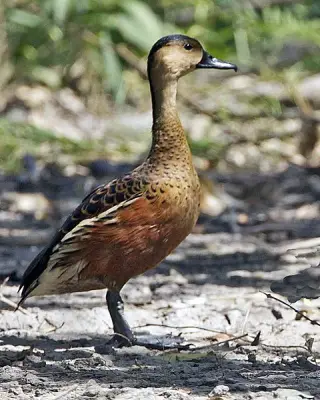
- Scientific Name: Dendrocygna arcuata
- Lifespan: 10-15 years
- Size: 21-23 in
Wandering whistling ducks are medium-sized whistling duck species found in Indonesia, Borneo, Phillippines, Papua New Guinea, and Australia.
They inhabit deep lagoons, flooded grasslands, and dams and were once called tree ducks.
As the name suggests, whistling ducks were named after their loud whistling calls and whistling noises their wings make during flight.
Wandering whistling ducks have very long necks and legs, giving them a very upright appearance.
They have red-brown plumage, pale faces, dark crowns and hindnecks, and dark brown spots on their bellies.
They breed from December to May, build their nests close to the water in high grasses, and lay 6-15 eggs.
Wandering whistling ducks forage by dabbling or diving and have a diet consisting of grass, waterlily, insects, and aquatic vertebrates.
There are 3 subspecies of these long-necked ducks.
Ruddy Shelduck
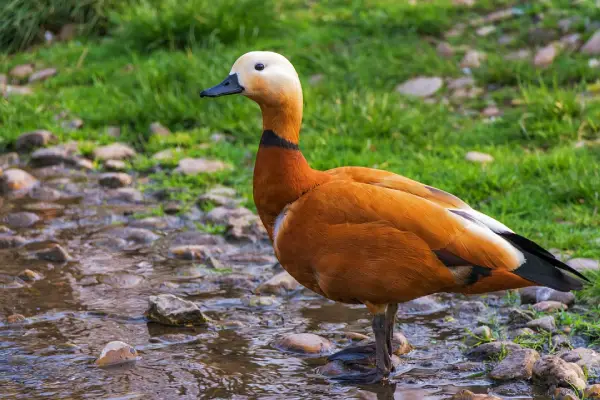
- Scientific Name: Tadorna ferruginea
- Lifespan: n/a
- Size: 23-28 in
These distinctive waterfowl with orange-brown plumage, creamy-white heads, black tails, black bills, and black flight feathers are also known as Brahminy ducks.
Ruddy shelducks breed in wetlands, lakes, and rivers of southeastern Europe and Central Asia and winter in streams, sluggish rivers, ponds, flooded grassland, marshes, and brackish lagoons of Southern Asia.
Ruddy shelducks have long necks that they keep high and straight when swimming. Males have orange-brown necks; females have them pale and whitish.
Identify them by their loud honking calls.
Source: Pascal Christe, CC BY-SA 4.0, via Wikimedia Commons
Ruddy shelducks nest around trees and cliff holes and lay 6-12 creamy-white eggs that females incubate; both parents will take care of the ducklings.
They are monogamous and mate for life; ruddy shelducks become very aggressive during their breeding season.
Females will try to scare away intruders by lowering their heads, stretching their necks, and making loud calls. If that doesn’t work, they will run back to the males and encourage them to deal with the intruder.
These mostly nocturnal birds are omnivores and feed on grass, grain, plants, and invertebrates.
According to some estimates, ruddy shelducks have a global population of 170,000-225,000 birds.
Black-bellied Whistling Duck
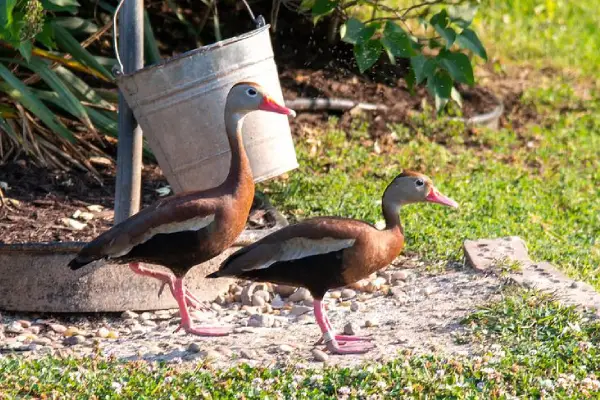
- Scientific Name: Dendrocygna autumnalis
- Lifespan: 15 years in captivity
- Size: 19-22 in
Black-bellied whistling ducks are medium-sized ducks with long necks and legs.
They are also known as black-bellied tree ducks and generally speaking, they are one of the most erect of all ducks.
Compared to other ducks, black-bellied whistling ducks have extremely elongated legs and necks and slower flights – this is a characteristic of geese and swans and might suggest a close relation between them.
Black-bellied whistling ducks are found in North, Central, and South America.
They are one of the two whistling duck species native to North America; in the USA, they can be seen year-round in Florida, southeast Texas, coastal parts of Alabama and Mississippi, and in Arizona during summer.
These long-necked ducks inhabit marshes, lakes, rice fields, and swamps.
Black-bellied whistling ducks have chestnut and black plumage, pink legs and beaks, gray faces and necks, bold white wing stripes seen during flight, and white eye-rings.
Identify them also by their whistling “waa-choo” calls.
Source: Oliver Komar, CC BY-SA 4.0, via Wikimedia Commons
They are very social and form huge flocks outside of the breeding season, sometimes including hundreds of birds.
Black-bellied whistling ducks are monogamous and pair for many years – both parents incubate the eggs and raise the ducklings. They are cavity nesters and make their nests in tree hollows where they lay 9-18 milky white eggs.
Females might resort to “egg dumping” where they lay their eggs in the nests of other black-bellied whistling ducks.
Black-bellied whistling ducks mostly forage at night and feed on plants, insects, spiders, snails, mollusks, and tadpoles.
Scientists estimate a total population of 1-2 million birds.
Northern Pintail

- Scientific Name: Anas acuta
- Lifespan: up to 22 years in the wild
- Size: 23-30 in
These large ducks are widespread across North America, Europe, and Asia.
Northern pintails are one of the most numerous duck species in the world and got their name from the long central tail feathers males have.
Males are mostly gray and have chocolate brown heads, white breasts, a white stripe extending up the side of their necks, and bluish bills they use to filter out seeds and insects.
Females are patterned light brown and have gray-brown heads and shorter tails than males.
Northern pintails can be identified by their slender and long necks held straight during flight.
Males will often make soft “proop-proop” whistling calls while the females make low croaks and mallard-like quacks.
Source: Unknown author, Public domain, via Wikimedia Commons
In North America, northern pintails breed in wet grassland, lakesides, and tundras of Canada, Alaska, and the Midwestern USA.
They are one of the earliest nesting ducks there and their breeding season lasts from April to June; a female will lay 7-9 creamy eggs.
When the winter comes, they move to sheltered estuaries, brackish marshes, and coastal lagoons of Southern USA, Mexico, Central, and South America.
They are very social birds outside the breeding season and will often mix with other ducks.
Northern pintails feed by dabbling in shallow waters, consuming plants, aquatic insects, mollusks, and crustaceans.
Thanks to their elongated necks, northern pintails can grab food items from the 12-inches-deep bottoms of water bodies; something that other dabbling ducks like mallards can’t reach.
Read More: More examples of blue-billed ducks
Indian Runner Duck
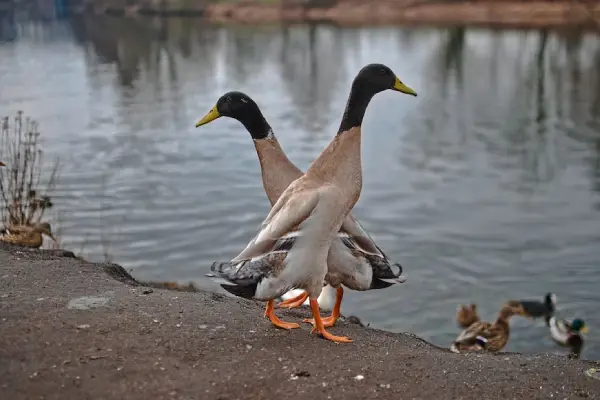
- Scientific Name: n/a
- Lifespan: 8-12 years
- Size: 20-26 in
Indian runner ducks are a breed of domestic ducks.
They are native to southeast Asia but have been domesticated and spread throughout the world.
Due to their upright posture, small heads, and large bodies, they can be easily identified.
Indian runner ducks have very long and slender necks.
They do not fly or waddle but run and can have black, white, chocolate, fawn, white, or blue plumage.
Females can lay from 180-300 greenish-white eggs a year, often dropping their eggs everywhere.
Unlike some other ducks, Indian runners do not need water to breed and can be often seen foraging in meadows, looking for worms, flies, and slugs.
They are not so noisy and will make some quacks (females) and hoarse whispers (males).
Indian runner ducks were named so because the ship that imported them to England was from India.
Fulvous Whistling Duck

- Scientific Name: Dendrocygna bicolor
- Lifespan: up to 11 years
- Size: 18-21 in
Fulvous whistling ducks are caramel-brown and black whistling ducks found in North, Central, and South America, Africa, and Asia.
They are also known as fulvous tree ducks and can be identified by their conspicuous long necks and legs, blue-gray bills, and white stripes on their sides.
These long-legged and long-necked creatures are commonly found in warm freshwater marshes, shallow lakes, and flooded rice fields.
Similar to other members of their genus, fulvous whistling ducks make whistling sounds given on the ground or in flight; males have wheezy while females have more nasal and squeaky calls.
Pairs are monogamous and mate for life and have a clutch of 10 whitish eggs.
Fulvous whistling ducks forage by wading or diving and feed on plants and some aquatic worms, insects, and mollusks.
They can be seen in small flocks together with black-bellied and white-faced whistling ducks.
In the USA, these ducks can be seen in Texas, Florida, and California.
Muscovy Duck
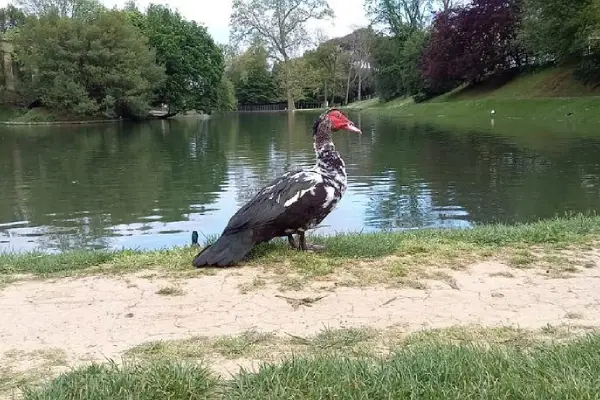
- Scientific Name: Cairina moschata
- Lifespan: 8-12 years
- Size: 25-34 in
These large ducks are native to Mexico, Central, and South America – they originated in Brazil.
Male muscovy ducks are twice the size of females and measure around 30 inches in length and weigh up to 15 pounds – this makes them one of the biggest ducks in North America.
Domesticated muscovy ducks are mostly black and white; they have white heads with crests on their napes, multicolored beaks (black, pink, or yellow), and pink-red wattles around the beaks.
Identify males by their low breathy calls and females by their quiet trilling “coo“.
Muscovy ducks also have long necks that can make them look like small geese.
They are omnivores and feed on small fish, snails, seeds, and larvae.
They inhabit forest swamps, lakes, and streams and nest in tree holes where they lay 8-16 eggs.
In the USA, wild muscovy ducks were introduced and have a very limited range; the largest population is in the Rio Grande Valley in Texas.
Despite sharing the name with a region surrounding Moscow in Russia, it is thought that they were named after the 16th century “Muscovy Company” which transported these ducks to England and France.
Plumed Whistling Duck
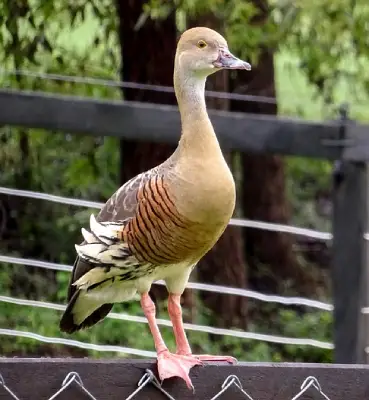
- Scientific Name: Dendrocygna eytoni
- Lifespan: n/a
- Size: 16.5-23.5 in
Plumed whistling ducks, also known as grass whistling ducks, are large pale ducks found in Australia.
These whistling ducks have brown-colored upperparts, white underparts, conspicuous plumes on their flanks, and very long necks.
They also have pink beaks and legs and yellow eyes.
Identify plumed whistling ducks also by their whistling calls.
Thanks to their elongated necks, these ducks stand tall and can be seen in large flocks around the edges of ponds, lakes, dams, or in agricultural lands.
Instead of diving for food, plumed whistling ducks feed by cropping grass.
They breed from January to April and lay 10-12 cream-colored eggs.
These odd species of duck are mostly terrestrial and more nocturnally active than most other species.
White-faced Whistling Duck
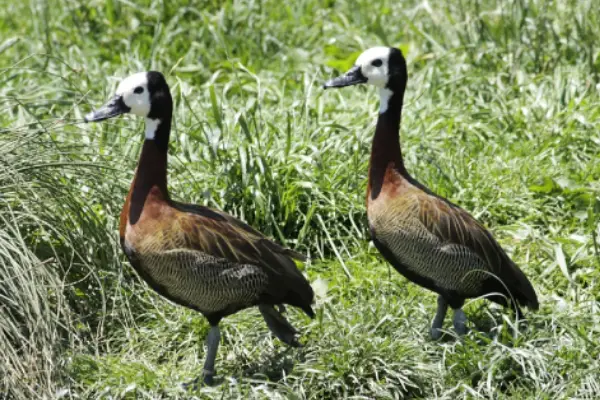
- Scientific Name: Dendrocygna viduata
- Lifespan: 15 years
- Size: 16 in
These whistling ducks are found in South America and sub-Saharan Africa.
White-faced whistling ducks are also known as white-faced tree ducks or whistling teals and can be recognized by their high-pitched whistling contact calls.
Source: Alex Dunkel (Maky), CC BY-SA 3.0, via Wikimedia Commons
White-faced whistling ducks have reddish chestnut-brown breasts, barred flanks, and white heads with black napes.
Similar to all other whistling ducks, their long necks and legs give them a gooselike appearance.
White-faced whistling ducks inhabit still freshwater lakes or reservoirs that have lots of vegetation where these ducks can feed during the night on insects, mollusks, crustaceans, grass, seeds, and other plants.
These very social birds can gather in groups of several thousand during the non-breeding season. They nest in pairs and small groups, place their nests on the ground, and lay 4-13 eggs that both parents incubate.
After the breeding season ends, white-faced whistling ducks will molt and lose their primary feathers for around 3 weeks.
During that period, they can neither swim nor fly and have to remain on land.
Read More: More examples of white-headed ducks
Indian Spot-billed Duck
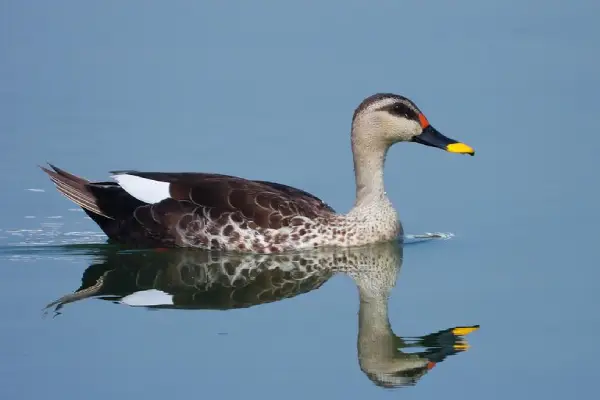
- Scientific Name: Anas poecilorhyncha
- Lifespan: n/a
- Size: 22-25 in
These large grayish-brown ducks have black beaks with yellow tips.
Indian spot-billed ducks were named after a red spot at the base of the beaks and can be found in Asia.
They are rather large dabbling ducks that measure from 22 to 25 inches in length, span 33-37 inches across the wings, and weigh from 1.7 to 3.3 pounds.
Indian-spot billed ducks have mostly gray plumage, pale heads, and green patches boarded in white on their wings. Their long necks are mostly pale.
They breed according to the rain season, mostly from July to September or November to December, nest on the ground, close to the water, and lay 8-14 eggs.
Indian spot-billed ducks are very social outside of breeding season and can be often found in small flocks around freshwater lakes and marshes.
They forage by dabbling and consume plants.
Identify them also by their calls that resemble those of mallards.
Source: Sharad Apte, CC BY-SA 3.0, via Wikimedia Commons
Lesser Whistling Duck

- Scientific Name: Dendrocygna javanica
- Lifespan: up to 9 years in captivity
- Size: 16.5 in
Lesser whistling ducks are small whistling ducks found in southeast Asia.
They are also known as Indian whistling ducks or lesser whistling teals and can be found in shallow water bodies with abundant vegetation, around paddy fields and lakes.
They resemble fulvous whistling ducks but the main difference is the uppertail coverts – they are chestnut-colored in lesser ducks and creamy white in fulvous ones.
Lesser whistling ducks have pale brown plumage, brown crowns and napes, brownish underparts, and chestnut-fringed backs.
Identify them also by their dark gray legs and beaks and long necks.
Lesser whistling ducks are very social birds with loud wheezy whistling “seasick-seasick” calls.
They feed during the night, forage by dabbling or diving, and consume plants, small fish, worms, and frogs.
These brown long-necked ducks breed during the monsoon season, nest in tree holes, and lay 7-12 white eggs that both parents incubate.
Eastern Spot-billed Duck
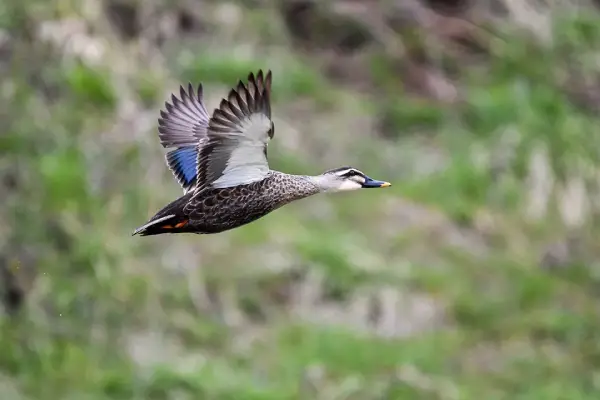
- Scientific Name: Anas zonorhyncha
- Lifespan: n/a
- Size: 22-25 in
Eastern spot-billed ducks or Chinese spot-billed ducks are large dabbling ducks found in eastern and southeastern parts of Asia.
They were once regarded as subspecies of the Indian spot-billed ducks and got their names from the yellow spots on their black beaks.
Eastern spot-billed ducks inhabit ponds, lakes, wet fields, and estuaries and can be identified by their dark brown plumage, pale heads, and two black stripes on their faces.
When resting, their long necks are distinctive – the species have the whitish to buffy white color of their necks.
Males and females look alike but males are larger.
Eastern spot-billed ducks breed in China, Japan, Mongolia, and Russia and can be also identified by their quacking calls, similar to those of mallards.
Their breeding season depends on the range and water level but it’s usually from April to July.
They nest on the ground close to water, use weeds, grass, and some feathers as building materials, and have a clutch of 7-10 grayish-white eggs. Females incubate the eggs alone, but males stay nearby to protect them.
Eastern spot-billed ducks forage by dabbling (submerging their heads in water) and consume seeds, grasses, insects, worms, and water snails.
Although mostly seen in pairs or small groups, these ducks might form flocks with up to 100 individuals.
Summary
This concludes our list of ducks with long necks.
Examples of long-necked ducks include several types of whistling ducks, dabbling ducks, some breeds of domestic ducks, etc.
Hopefully next time you see these birds, you will recognize any of them with ease!
And if you enjoyed this article, here are our other popular reads on birds: Examples of ducks that have red eyes